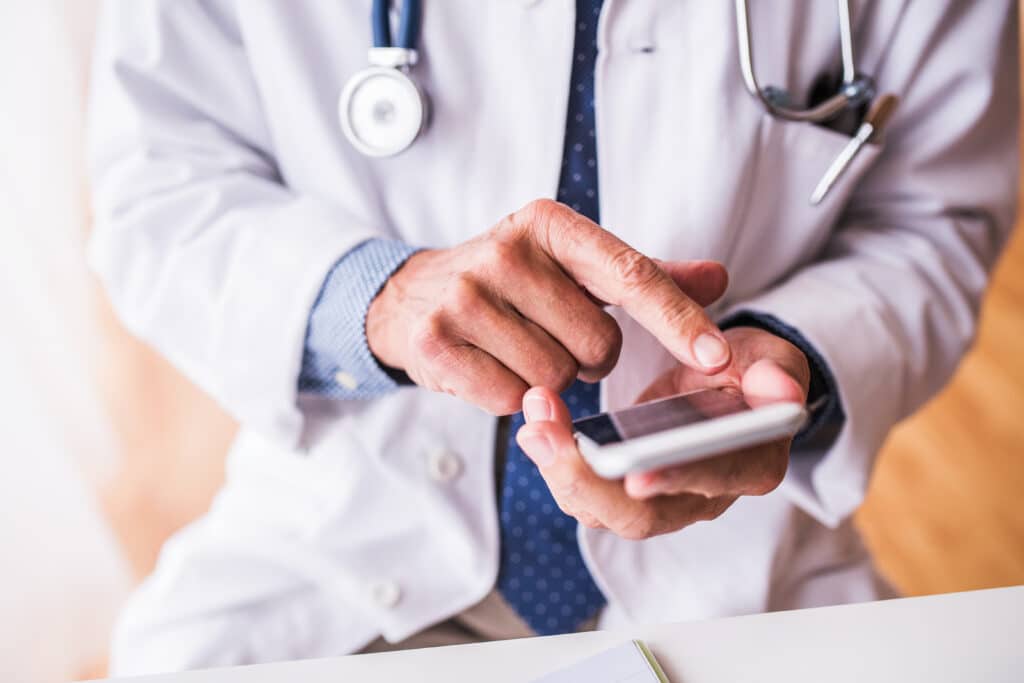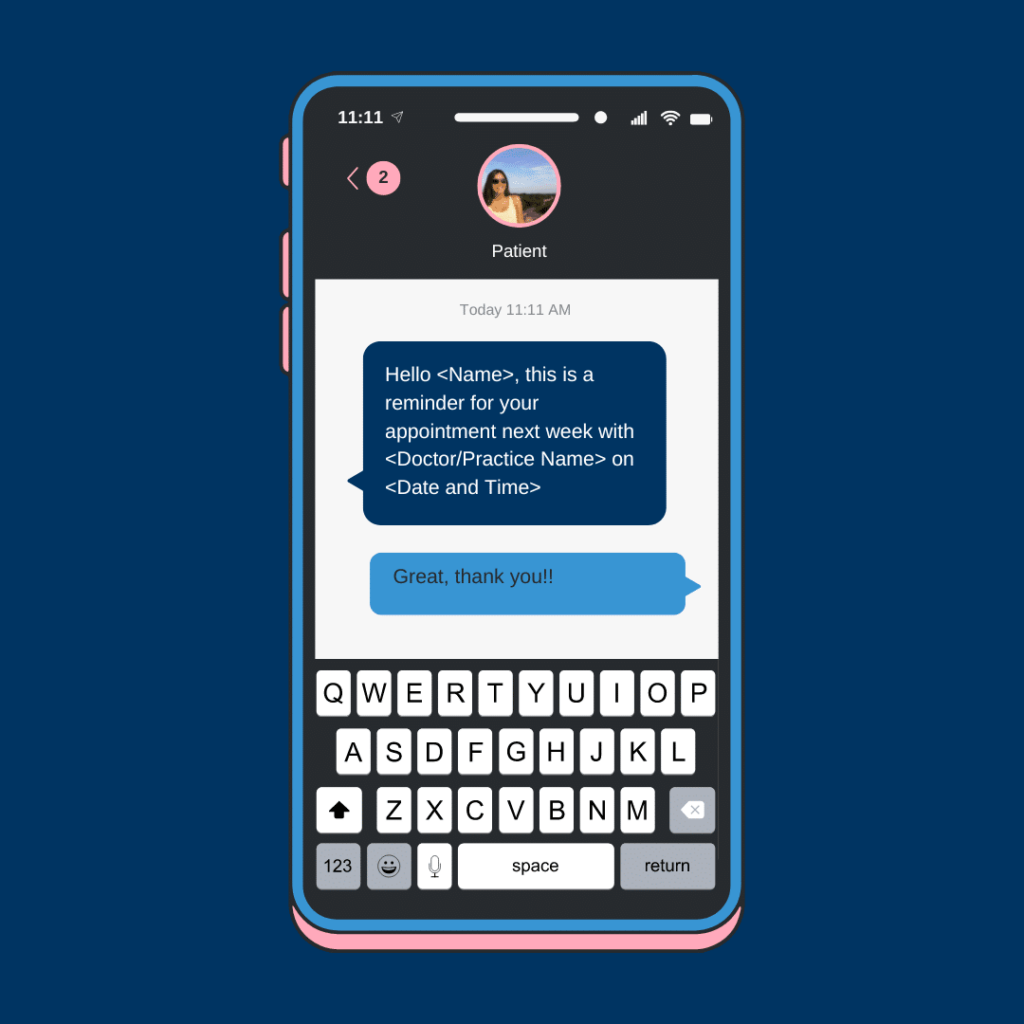Clear, timely communication between patients and healthcare providers is essential for positive health outcomes. Studies show that effective communication improves patient satisfaction, treatment adherence, and overall health results. To achieve these benefits, providers need reliable ways to reach patients efficiently.
Text messaging has become a highly effective tool in healthcare, with nearly 97% of Americans owning a mobile phone. Even patients without data services can receive SMS messages, making it an accessible option for most.
Text messages can serve as reminders for appointments, treatments, or medications, helping patients stay on track with their care. They also allow staff to quickly communicate essential information, such as test results or health updates, directly to patients.
In this article, we’ll explore the critical role of communication in healthcare and discuss how your practice can leverage SMS messaging to enhance patient engagement. We’ll also outline steps to integrate texting into your practice for improved patient communication and care outcomes.
RELATED ARTICLE: How to Engage Patients in Telehealth
Effective Strategies to Use Text Messaging in Your Healthcare Practice
Text messaging offers numerous ways to enhance patient communication and streamline operations. Here are eight effective uses for text messaging that add value and convenience to your healthcare practice:
- Appointment Reminders: Send automated text reminders to reduce no-shows. Providers can also use texts to remind patients when it’s time to take medications, supporting better adherence to treatment.
- Patient Education: Use text messages to share health tips, recovery advice, or lifestyle recommendations. You can include links to credible resources, helping patients access reliable information.
- Recovery Support: Follow up with patients after procedures or treatments via text to monitor their recovery and provide support at each stage. This offers a convenient way for both patients and staff to track progress.
- Symptom Triage: Allow patients to text symptoms or describe minor injuries. Staff can assess their condition and advise on whether further medical care is needed, helping to reduce unnecessary visits and ensuring quick care for those who need it.
- Lab Results: Send notifications to inform patients when lab results are ready, along with instructions to access them online. Physicians can follow up with comments to explain results or suggest next steps.
- Billing and Payments: Use text messages to remind patients about upcoming co-pays or outstanding balances. You can also verify or update insurance information, ensuring patients are prepared for their visits.
- Patient Feedback: Gather immediate feedback through text surveys. Patients can conveniently rate their experience with staff and facilities without needing to log in to a portal, enhancing response rates.
- Behavioral Support and Treatment: For ongoing support, text messages can assist with behavioral health goals, such as smoking cessation or managing chronic conditions. Text-based reminders keep patients on track between visits.
Additionally, text messaging can be used for public health advisories. For example, you can alert patients to health outbreaks, offer information on new immunizations, or notify them of preventive care opportunities.
RELATED ARTICLE: Patient Appointment Reminder Text Message Samples & Tips
Benefits of Text Messaging for Patient Engagement in Healthcare
Text messaging offers a powerful tool to boost patient engagement, which is shown to improve health outcomes and the quality of care. Both the Journal of Patient Experience and the Centers for Disease Control and Prevention (CDC) highlight the vital role of engagement in achieving better health results.
Here are specific ways text messaging benefits patient engagement in your practice:
- Encourages Two-Way Communication
Text messaging makes two-way communication easy and accessible. With 33% of Americans preferring texting over other communication methods and 98% of texts opened within 90 seconds, patients are more likely to read and respond quickly. This convenient communication channel allows patients to share pre-appointment information, ask questions, and receive answers without the hassle of emails or voicemails. - Personalizes Patient Care
Personalized messaging has been shown to increase patient engagement. By tailoring texts to specific healthcare needs, such as reminders for screenings based on personal or family history, or managing chronic conditions, your practice can help patients feel more valued and supported. This personalized approach empowers patients to take proactive steps in managing their health. - Increases Adherence to Treatment Plans
Texting is an unobtrusive way to support patients in following their treatment plans. Reminders for medications, appointments, and necessary lifestyle changes help patients stay on track, particularly those with complex health needs. Two-way texting also allows providers to monitor patient progress and make adjustments based on real-time feedback. - Improves Health Literacy
Text messages can educate patients with simple, reliable health tips, such as advice on nutrition or reminders to wash hands to prevent illness. By providing ongoing health education, your practice empowers patients to make informed choices, reducing their reliance on potentially unreliable sources of information online.

The Importance of Effective Communication in Healthcare Practices
Text messaging is an effective way to communicate with patients, reaching nearly everyone while allowing for convenient, asynchronous interaction. Unlike phone calls, texts don’t require an immediate response, enabling patients to read messages when it’s convenient for them.
Studies show that text messaging is a preferred communication method for many patients. For instance, 20% of patients find texting more convenient than online portals, while 79% want the option to communicate with providers via text. Among practices that offer text messaging, 77% of patients value this service.
Effective communication through text messaging offers numerous benefits for healthcare practices. It enhances the patient experience by providing convenient reminders and a direct line to healthcare providers, creating a more seamless and positive interaction.
Patients also experience increased satisfaction, as text messaging offers a quick and accessible way to ask questions or seek clarification, strengthening their relationship with their providers.
Additionally, text messages improve patient education, allowing healthcare providers to share valuable health tips—such as advice on healthy eating or the importance of immunizations—thus supporting patients in managing their health from home.
For staff, text messaging boosts efficiency by reducing the need for time-consuming phone calls. Automated reminders save staff time, enabling them to focus on more critical tasks and contributing to greater overall practice efficiency.
In summary, text messaging provides a convenient, time-saving, and patient-centered communication channel that benefits both patients and healthcare providers.
FROM ONE OF OUR PARTNERS: 10 Ways To Automate Your Business
Top Takeaway Tips for Text Messaging in Healthcare
There are obvious benefits to using text messaging in your healthcare practice. However, you should also consider the potential challenges. For instance, your messaging system needs to comply with HIPAA privacy regulations.
Consider these four tips to get started with text messaging in your healthcare practice:
- Talk to your staff. Start the process by communicating with your caregivers. Learn the type of communication they want to have with patients. This information can help you decide which type of SMS system to consider. Automated appointment reminders might be sufficient in some cases. In others, staff may prefer systems enabled for two-way texting.
- Get patient feedback. You should also collect insights from patients. Learn if they would use a two-way texting system. And find out what types of texts they would like to get. You should do this first so that you know which features your SMS system should have.
- Learn about compliance issues. Like other healthcare communications, texting needs to comply with HIPAA regulations. You need a secure SMS system that properly protects patient information. Learn about these rules first. Then, you can verify that your chosen texting software is compliant before you purchase it.
- Find free trials or demos. You should test texting software before purchasing. Find software providers offering trials or demos. You can then call on select staff members to test the tools. These tests can verify that the software does what you expect and works properly in real-world settings.
With the right texting software, you can enjoy the benefits of text messaging in healthcare. These tools can help you ensure security and improve patient engagement and outcomes.





